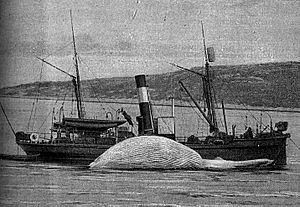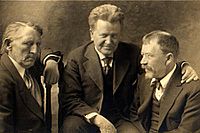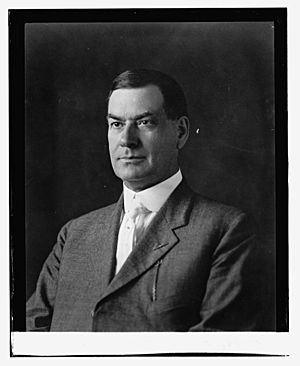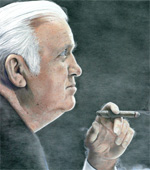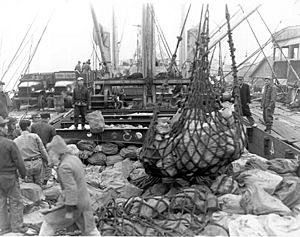Maritime history of the United States (1900–1999) facts for kids
The United States merchant marine, which are the ships and sailors that carry goods and people, grew a lot during the 1900s. This period saw many changes, including new laws, the rise of powerful unions, and the merchant marine's vital role in two World Wars and other conflicts.
Contents
- Early 1900s: New Worker Groups
- 1910s: Laws for Sailors
- World War I: Protecting Ships
- 1919-1930: Union Ups and Downs
- 1930-1941: Unions Grow and Change
- 1940s: World War II and Ship Building
- 1950s: Post-War and Korean War
- 1960s: New Agencies and Vietnam War
- 1970s: Changes and Readiness
- 1980s: Leadership Changes
- 1990s: Union Autonomy and Humanitarian Aid
- Images for kids
Early 1900s: New Worker Groups
In 1905, a group called the Industrial Workers of the World (IWW), also known as "the Wobblies," was started. This group mainly helped workers who didn't have special skills. They were important in American labor for about 15 years.
Andrew Furuseth became the president of the International Seamen's Union (ISU) in 1908. He led the union until 1938.
1910s: Laws for Sailors
Important people in maritime history were born during this time. Harry Lundeberg was born in 1901, and Joseph Curran was born in 1906. Both would become major leaders in sailor unions.
The RMS Titanic was the biggest steamship in the world when it sank in 1912. Later, the RMS Queen Elizabeth (launched in 1938) became the largest passenger steamship ever built. The Queen Elizabeth 2 was launched in 1969.
Paul Hall (labor leader), another future labor leader, was born in 1914.
Andrew Furuseth worked hard to pass new laws for sailors. These efforts led to the Seamen's Act of 1915.
During World War I, there was a huge demand for shipping. The ISU's membership grew to over 115,000 members. But after the war, membership dropped to 50,000.
The Seamen's Act of 1915 changed life for American sailors. Here are some key things it did:
- It stopped the practice of putting sailors in jail for leaving their ship.
- It made punishments for not following orders less harsh.
- It set rules for how many hours a sailor could work, both at sea and in port.
- It required a minimum quality for ship's food.
- It regulated how sailors' wages were paid.
- It required specific safety levels, especially having enough lifeboats.
- It required a certain percentage of sailors on a ship to be qualified Able Seamen.
- It required at least 75 percent of the sailors to understand the language spoken by the officers.
On January 28, 1915, President Woodrow Wilson signed a law that created the United States Coast Guard. This new service combined the Revenue Cutter Service and the Lifesaving Service. Over time, the Coast Guard also took over the Lighthouse Service and the Navigation and Steamboat Inspection Service.
World War I: Protecting Ships
During World War I, Great Britain, an island nation, relied heavily on goods brought in by ship. Germany used its submarines, called U-boats, to sink these merchant ships. U-boats were very good at this, even when Allied ships controlled the surface of the ocean.
By 1915, Germany was trying to block Britain by sinking cargo ships, including passenger ships. Submarines had to be sneaky and couldn't stand up to a direct attack from a surface ship. This meant they often couldn't warn ships before attacking or rescue survivors. Many civilians died, which made neutral countries like the United States angry. This was a big reason the U.S. eventually joined the war.
To protect their ships, the Allies started using convoys. This meant many merchant ships would travel together, protected by warships. The British Royal Navy had used convoys before, but there was a debate about using them for merchant ships. Some worried that putting many ships together would make them an easier target for U-boats. Others feared it would cause collisions and be a huge challenge to organize.
After trying out convoys in early 1917, they proved successful. The first official convoys started in late May. By autumn, the convoy system was well organized. The number of ships lost in convoys dropped a lot. Only 2% of ships in convoys were lost, compared to 10% for ships traveling alone.
The war showed how important it was to manage the merchant marine during wartime. Submarines and merchant raiders caused huge losses to the Allied merchant fleet. In 1917, U-boats were sinking ships faster than new ones could be built.
1919-1930: Union Ups and Downs
The ISU had a successful strike in 1919, which led to the highest wages ever for deep-sea sailors during peacetime.
However, the ISU also had problems. In 1921, after contract talks failed, the ISU called a strike at all ports. The strike only lasted two months and failed. This resulted in a 25 percent cut in wages. Many criticized the ISU for being too traditional.
Joseph Curran began working on ships in 1922. In 1929, the California Maritime Academy was established to train future sailors.
Merchant Marine Act of 1920: The Jones Act
The Merchant Marine Act of 1920 is a U.S. federal law that protects all maritime workers. This includes people who work for shipping companies, offshore oil rigs, and fishing boats. The act set up important rules that are still used today.
The most important part of this act is called the Jones Act. It controls how goods are transported between U.S. coastal ports. All goods traveling from one U.S. port to another must be carried by ships that meet Jones Act rules. These ships must be built in America, have American sailors, and be owned and registered in the United States.
The Merchant Marine Act of 1920 was created to build and keep a strong American merchant marine. This is important for national defense and for the growth of U.S. trade. The act aims for U.S. ships to carry most of America's goods.
The Jones Act is named after Senator Wesley Livsey Jones, who helped create it. It helps protect American jobs, national security, and the U.S. economy. For example, the United States Navy gives a lot of work to the American shipping industry by having them fix and build their ships. Without the Jones Act, other countries could transport goods in U.S. waters. This could be a serious threat during wartime.
The Jones Act also makes sure that ships follow strict U.S. maritime safety rules. These rules help reduce injuries at work and protect marine wildlife by setting limits on pollution. Having American sailors operate in American ports also makes communication easier and increases security.
1930-1941: Unions Grow and Change
In 1933, John L. Lewis started the Committee for Industrial Organizations (CIO) within the AFL. The CIO later became its own group in 1938.
Harry Lundeberg joined the Sailor's Union of the Pacific (SUP) in Seattle in 1934. The ISU became weaker when the SUP left it in 1934. The ISU said the SUP was being influenced by "radicals" and demanded they stop working with the Maritime Federation. The SUP refused, and the ISU took away their official recognition.
The ISU was involved in the 1934 West Coast waterfront strike. This strike lasted 83 days and led to all West Coast ports becoming unionized. Sailors on the West Coast left their ships to support the longshoremen (dockworkers). This left over 50 ships sitting idle in San Francisco harbor. During clashes with police, three picketers were killed. After the strike, sailors got better pay, better living conditions, and a three-watch system (meaning more rest).
In 1935, the Maritime Federation was formed to represent different maritime unions. Harry Lundeberg became its first president. He was also named Secretary-Treasurer of the SUP.
The U.S. merchant marine was struggling in the mid-1930s. Few new ships were being built, and old ships were not efficient. Unions were fighting each other, and ship owners were fighting with unions. To fix this, Congress passed the Merchant Marine Act of 1936. This act created the United States Maritime Commission. Its goal was to develop and maintain a strong American merchant marine, promote U.S. trade, and help with national defense.
The commission realized that trained sailors were very important for the country. They worked with the Coast Guard to create the United States Maritime Service in 1938. This program used both civilian and Coast Guard instructors to train merchant mariners.
In 1936, Joseph Curran led the S.S. California strike.
On February 14, 1937, Michael Sacco was born. He would later become a major union leader.
On January 22, 1938, Andrew Furuseth died. Later that year, on October 15, 1938, the Seafarers International Union of North America (SIU) was officially formed.
Rise of the National Maritime Union
In 1936, Joseph Curran, a boatswain (a ship's officer), became well known. From March 1 to 4, he led a strike on the S.S. California in San Pedro, California. Sailors along the East Coast also went on strike to protest how the S.S. California's crew was treated. Curran became a leader of this 10-week strike.
In October 1936, Curran called another strike to improve working conditions and challenge the ISU. This four-month strike stopped 50,000 sailors and 300 ships on the Atlantic and Gulf coasts.
Curran believed it was time to leave the old-fashioned ISU. He started asking sailors to join a new union. Many ships were delayed because sailors were listening to organizers and signing up for the new union.
In May 1937, Curran and other leaders formed the National Maritime Union (NMU). At its first meeting in July, about 30,000 sailors switched from the ISU to the NMU. Curran was elected president. Within a year, the NMU had over 50,000 members.
Formation of Seafarer's International Union
In August 1937, William Green (labor leader), the president of the American Federation of Labor (AFL), took control of the ISU to rebuild it. On October 15, 1938, Green gave Harry Lundeberg the official charter for the Seafarers International Union of North America (SIU). The new union represented 7,000 members on the East and Gulf coasts. Today, the SIU still holds the charters for both the NMU and SUP.
1940s: World War II and Ship Building
When the United States entered World War II, the merchant marine and Coast Guard had to grow very quickly. The Maritime Commission created the War Shipping Administration in 1942. This new agency handled important war tasks, including maritime training.
The U.S. planned to build many ships quickly to help with the war. The Maritime Commission started a huge shipbuilding program. Experienced shipyards built complex warships. New shipyards, which appeared almost overnight, built simpler ships like the emergency Liberty ships. By 1945, shipyards had built over 2,700 "Liberty" ships and hundreds of "Victory" ships, tankers, and transports.
All these new ships needed trained officers and crews. The Coast Guard provided much of the advanced training for merchant marine personnel. Merchant sailors trained at large stations like Fort Trumbull in Connecticut and Government Island in California. Other training stations were added in Boston, Port Hueneme, California, and St. Petersburg, Florida.
The Coast Guard also used training ships like the American Seaman, American Mariner, and American Sailor. These ships were important for teaching sailors how to operate large vessels.
Thousands of sailors who worked on the new American merchant fleet were trained by the Coast Guard. This training was very important for winning the war.
The Atlantic Ocean was a major battle zone during World War II. When Germany declared war on the U.S., the East Coast of the United States became an easy target for German U-boats. From February to May 1942, 348 ships were sunk. U.S. naval commanders were slow to use the convoy system that had protected ships across the Atlantic. Also, without coastal blackouts, ships were easy to see against the bright lights of American towns.
Several ships were torpedoed close to cities like New York City and Boston. Some civilians even watched battles between U.S. and German ships from the beaches.
Once convoys and air cover were used, fewer ships were sunk. The U-boats then moved to attack shipping in the Gulf of Mexico, sinking 121 ships in June. For example, the tanker Virginia was torpedoed in the Mississippi River in May 1942, killing 26 crewmen. Again, when defenses were put in place, ship sinkings decreased.
This U-boat campaign was very damaging, causing a quarter of all wartime sinkings. This happened for several reasons: the U.S. Navy commander was against using British recommendations for convoys, U.S. patrols were easy for U-boats to avoid, and the U.S. Navy didn't have enough escort ships.
1950s: Post-War and Korean War
The United States Maritime Commission was ended in 1950. Its jobs were split between two new groups: the U.S. Federal Maritime Board (which regulated shipping and gave money for ship building) and the Maritime Administration (which managed training and the national defense reserve fleet).
The American Maritime Officers (AMO) union was started on May 12, 1949. It was first called the Brotherhood of Marine Engineers and was part of the Seafarers International Union of North America. Its first members were civilian sailors who had served in World War II.
Korean War: A Bridge of Ships
On March 13, 1951, the United States Secretary of Commerce created the National Shipping Authority (NSA). This group used ships from the Maritime Administration's National Defense Fleet (NDRF) to help the military and other government agencies. During wartime, the NSA could also take over privately owned merchant ships for military use.
During the Korean War, there weren't many major problems with moving goods by sea. About 700 ships from the NDRF were used to help in the Far East. Also, between 1951 and 1953, over 600 ships were used to carry coal to Europe and grain to India.
Commercial merchant ships were the main way supplies were moved across the Pacific Ocean. At the start of the war, only six ships were rented for this purpose, but this number grew to 255. Commercial vessels carried 85 percent of all dry cargo needed during the Korean War.
Merchant ships not only delivered supplies but also helped the Navy. When U.S. Army troops landed at Incheon in September 1950, 13 U.S. Navy cargo ships and 60 chartered merchant ships helped with the invasion.
The U.S. Merchant Marine quickly delivered supplies during the Korean War. At first, American troops didn't have enough equipment to fight the North Koreans. But military and commercial ships quickly brought the tools needed. Seven tons of supplies were needed for every soldier going to Korea, plus one more ton each month after that. Cargo ships unloaded supplies day and night, making Pusan a very busy port. The success of the U.S. Merchant Marine showed how important it was to be ready for sea transport during a crisis.
Merchant ships also played a big role in evacuating United Nations troops from Hungnam. After a difficult battle, the Merchant Marine and Navy evacuated over 100,000 U.N. troops and 91,000 Korean refugees. They also moved 350,000 tons of cargo and 17,500 vehicles in less than two weeks.
One famous rescue was by the U.S. merchant ship SS Meredith Victory. In December 1950, just hours before communists took over North Korea, this ship, built for only 12 passengers, carried over 14,000 Korean civilians from Hungnam to Busan. The ship's first mate, D. S. Savastio, who only had first aid training, helped with medical needs during the three-day trip. Ten years later, the crew received a special award for their bravery.
Privately owned American merchant ships helped move thousands of U.S. troops and their equipment. Admiral C.T. Joy, commander of U.S. Naval Forces in the Far East, praised their work. He said, "The Merchant Mariners in your command performed silently, but their accomplishments speak loudly."
Ships from the National Defense Reserve Fleet (NDRF) have helped in seven wars and crises. During the Korean War, 540 ships were activated. From 1955 to 1964, another 600 ships were used to store grain. After the Suez Canal closed in 1956, 223 cargo ships and 29 tankers were activated from the NDRF.
1953-1960: Union Growth and Mergers
In 1953, the Brotherhood of Marine Engineers (BME) gained independence within the SIUNA. This allowed them to create their own rules and elect their own leaders for the first time.
The BME's welfare plan grew quickly. By August 1954, it had over $100,000. The plan offered good benefits, like full surgery coverage for members and their families. In 1955, the union started working on the first pension plan for U.S. merchant marine officers.
In 1955, Joseph Curran became a vice-president of the AFL-CIO. The AFL and CIO merged in 1955 under the leadership of John L. Lewis.
In 1957, Wilbur Dickey resigned as BME president, and Raymond McKay took his place. Later that year, McKay and H.L. Daggett from the Marine Engineers' Beneficial Association (MEBA) signed an agreement. The BME merged with some MEBA groups, forming "MEBA's Great Lakes District Local 101."
On January 28, 1957, Harry Lundeberg died. Soon after, Paul Hall (labor leader) became president of the Seafarers International Union of North America. That same year, Raymond McKay became president of American Maritime Officers, which left the SIU and joined MEBA. Also in 1957, Michael Sacco joined the Seafarers International Union of North America.
1960s: New Agencies and Vietnam War
In 1960, after some changes within MEBA, American Maritime Officers became known as "District 2 MEBA."
In 1961, the Federal Maritime Commission took over the regulatory jobs of the Federal Maritime Board. The Maritime Administration handled the subsidy functions.
During the Berlin crisis of 1961, 18 ships from the National Defense Reserve Fleet were activated. They stayed in service until 1970. The Vietnam War required 172 NDRF ships to be activated.
Vietnam War: Civilian Sailors in Combat
During the Vietnam War, ships with civilian sailors carried 95 percent of the supplies used by American forces. Many of these ships sailed into combat zones and faced fire. For example, the Mayagüez incident involved the capture of sailors from the American merchant ship SS Mayaguez.
The crisis started on May 12, 1975. Forces from Cambodia seized the American container ship SS Mayagüez in international waters. They took its crew for questioning. The ship was later moved to an island called Koh Tang.
Sadly, the ship's crew had been released unharmed before U.S. Marines attacked. The U.S. forces did not know this. This incident was the last official battle of the United States' involvement in the Vietnam War.
1970s: Changes and Readiness
In 1970, the Merchant Marine Act allowed for a program to help pay for shipbuilding.
On March 5, 1973, Joseph Curran resigned as president of the NMU. Shannon J. Wall took his place.
In 1976, the first woman was allowed to join the U.S. Merchant Marine Academy.
Since 1977, the Ready Reserve Fleet (RRF) has taken over most of the work previously done by the National Defense Reserve Fleet. The RRF played a big part in Operation Desert Shield/Operation Desert Storm from 1990 to 1992. During this time, 79 ships were activated. They carried 25% of the military equipment and 45% of the ammunition needed.
1980s: Leadership Changes
In 1981, the Maritime Administration became part of the United States Department of Transportation.
On August 14, 1981, Joseph Curran died.
In 1988, Frank Drozak died. Michael Sacco replaced him as president of the Seafarers International Union of North America.
1990s: Union Autonomy and Humanitarian Aid
In 1992, "District 2" of MEBA went back to its original name, "American Maritime Officers."
In 1993, Raymond T. McKay died. His son, Michael McKay, became the president of American Maritime Officers.
AMO officially left MEBA in 1994. This meant they lost their connection to the AFL-CIO. However, this connection was restored on March 12, 2004, when Michael Sacco gave AMO a new charter from the Seafarers International Union of North America.
Two RRF tankers, two RO/RO (Roll-on/Roll-off) ships, and a troop transport ship were used in Somalia for Operation Restore Hope in 1993 and 1994. During the Haitian crisis in 1994, 15 ships were activated for Operation Uphold Democracy. In 1995 and 1996, four RO/RO ships delivered military cargo for NATO peacekeeping missions.
Four RRF ships were activated to provide help to Central America after Hurricane Mitch in 1998. Three RRF ships currently support the Afloat Prepositioning Force, providing fuel and supplies to the Navy.
Images for kids


